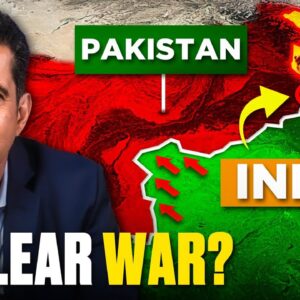In this video, Patrick Bet-David unpacks the complex and volatile relationship between India and Pakistan, two neighboring nations armed with nuclear capabilities and a long history of hostility.
Sparked by a recent terrorist attack in Jammu and Kashmir that left 26 Indian men dead, the situation is escalating by the minute…and the US and China may be pulled into the conflict.
Subscribe to Valuetainment for more deep dives, explainers, and motivational videos from PBD!
Background: A Deadly Attack Ignites Tensions
On April 22, 2025, a horrific terrorist attack in Jammu and Kashmir claimed the lives of 26 Hindu men. Perpetrated by a Pakistan-based militant group, the attackers reportedly executed their victims based on religious identity—sparing Muslim women but killing Hindu men after verifying their faith. The brazen brutality of the incident shocked India and the world, prompting swift and forceful retaliation from the Indian government.
India’s Military Response and Regional Fallout
In direct response to the April 22nd massacre, India launched a military strike against Pakistan. The airstrikes marked a dangerous escalation in long-standing hostilities between the two nuclear-armed neighbors. The Indian government, led by Prime Minister Narendra Modi, condemned the attack and vowed that the perpetrators would not be spared.
Pakistan, on the other hand, denied involvement, attributing the attack to non-state terrorist actors and disavowing responsibility. However, India accused Pakistan of supporting terrorism and initiated a multi-pronged retaliation campaign—not just militarily but diplomatically and economically as well.
Twelve Escalation Points in the India-Pakistan Crisis
India’s response wasn’t limited to a military strike. A broad series of retaliatory actions followed:
- Terrorist Retaliation & Accusations: India directly linked the attack to Pakistan’s state-sponsored terrorism and promised severe consequences.
- Water Treaty Suspended: India suspended the Indus Water Treaty, threatening Pakistan’s critical water resources—an act seen by Pakistan as crossing a nuclear red line.
- Border & Travel Restrictions: Land crossings closed; Pakistani nationals ordered to leave India. Both countries suspended rail and bus links.
- Airspace Closure: A mutual airspace ban was enacted until at least May 24.
- Maritime Ban: Sea routes and port access between both nations were halted.
- Visa Cancellations: Visas for Pakistani nationals, even medical, were revoked. The SARC visa program was terminated.
- Diplomatic Expulsions: Defense attachés expelled; embassy staff reduced; the Simla Agreement suspended.
- Trade & Financial Pressure: Pakistan halted trade; India remained economically unaffected and pushed for global sanctions against Pakistan.
- Sports Ties Severed: Cultural and sports exchanges were cancelled.
- Social Media Crackdowns: India banned several Pakistani social media accounts, including political figures.
- Military Posturing: Missile tests and troop build-ups on both sides of the Line of Control intensified.
- Internal Security Measures: India detained over 2,000 people in Kashmir, demolishing homes of suspected militants—sparking human rights concerns.
Historical Context: A Legacy of Violence and Distrust
The video also traced the deep-rooted animosity between India and Pakistan to the 1947 partition of British India. The division led to mass violence and the controversial status of Kashmir—a Muslim-majority region acceded to India by its Hindu ruler. Since then, the nations have fought multiple wars and engaged in several standoffs, including:
- The Kashmir Wars (1947–49, 1965)
- The Bangladesh Liberation War (1971)
- The Kargil War (1999)
- Major terror incidents: 2001 Indian Parliament Attack, 2008 Mumbai Attacks, and the 2019 Pulwama Bombing
The constant cycle of terror, military retaliation, and mutual distrust has cemented a near-perpetual state of hostility.
Nuclear Overhang: A Dangerous Stalemate
Both India and Pakistan are nuclear powers—India with 172 warheads and Pakistan with 170—raising global concerns about the risk of nuclear escalation. A Pakistani official ominously stated, “Our nuclear bombs are not meant to be displayed in museums.” Pakistan also reiterated its nuclear red lines, warning that violations related to water, territory, military, and internal subversion could trigger a nuclear response.
The Global Chessboard: China, Russia, and the U.S.
The geopolitical complexity deepens with the involvement of major powers:
-
China, reportedly unhappy with India’s growing appeal as a global manufacturing hub, may be covertly influencing Pakistan.
-
Russia, India’s largest arms supplier and oil partner, is likely to side with India despite its alignment with China in BRICS.
-
The United States, though currently uninvolved, could be drawn in if the conflict escalates further.
The possibility of proxy wars and regional destabilization evokes comparisons to the Cold War, with China potentially playing the role the USSR once did.
Conclusion: On the Brink
The India-Pakistan conflict has entered a perilous phase. The deadly terrorist attack, India’s forceful retaliation, and a cascade of escalating actions have created an environment ripe for further conflict. Even Iran—a nation frequently accused of destabilizing activities—has called for restraint, highlighting the gravity of the situation.
As tensions rise and global powers take sides, the world watches nervously. The potential for escalation—military, diplomatic, and nuclear—makes this one of the most dangerous flashpoints in contemporary geopolitics.


















Add comment